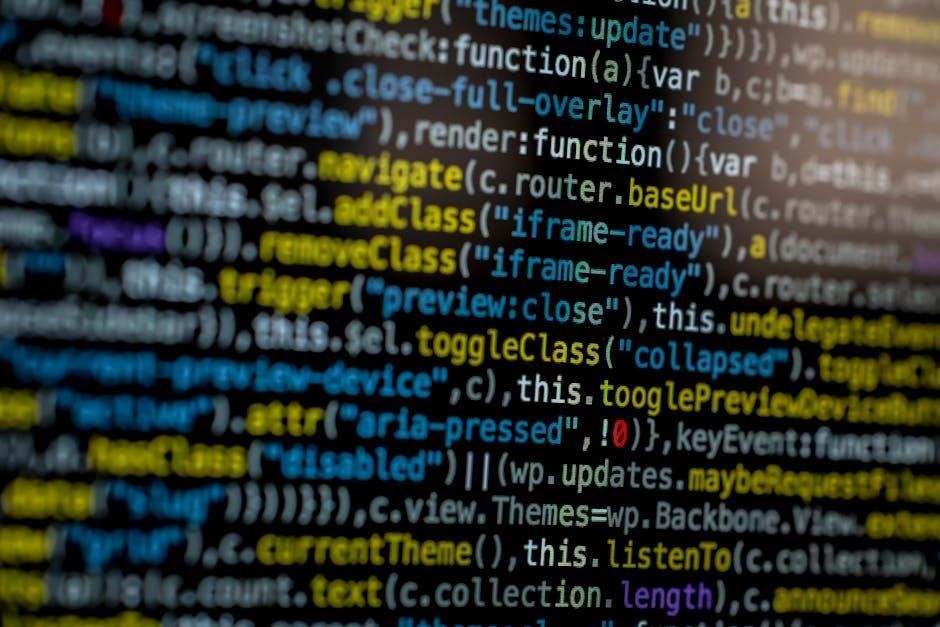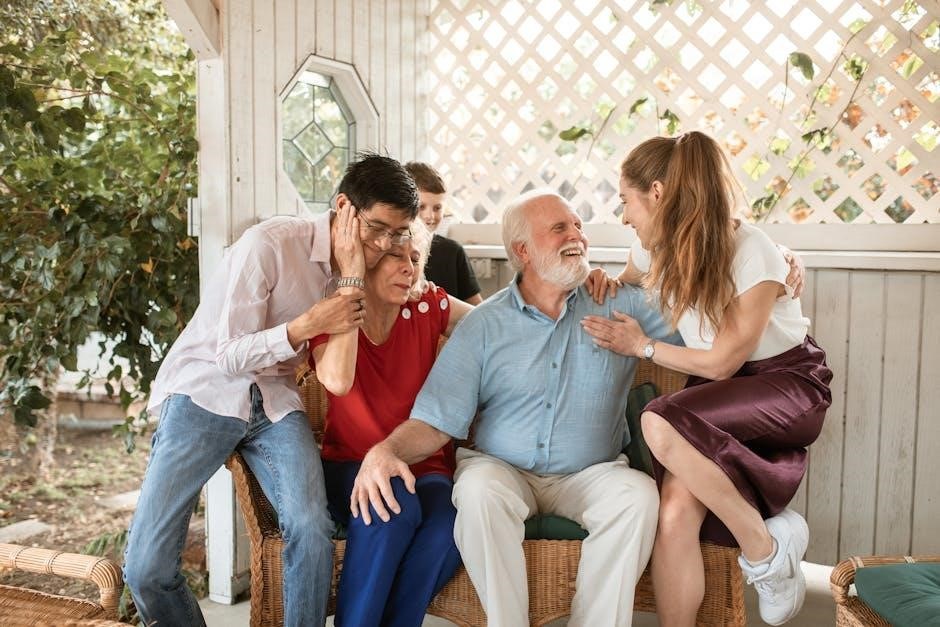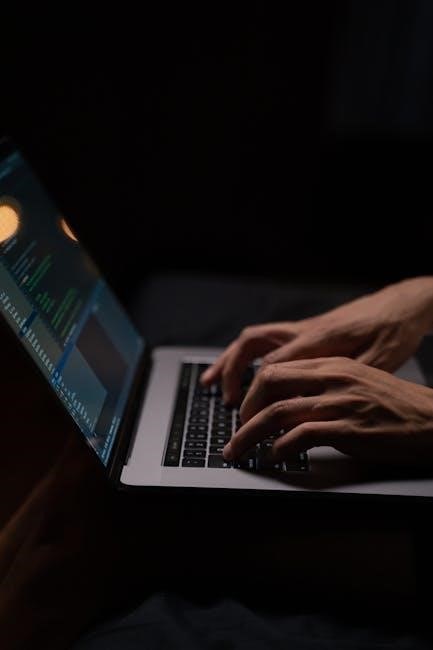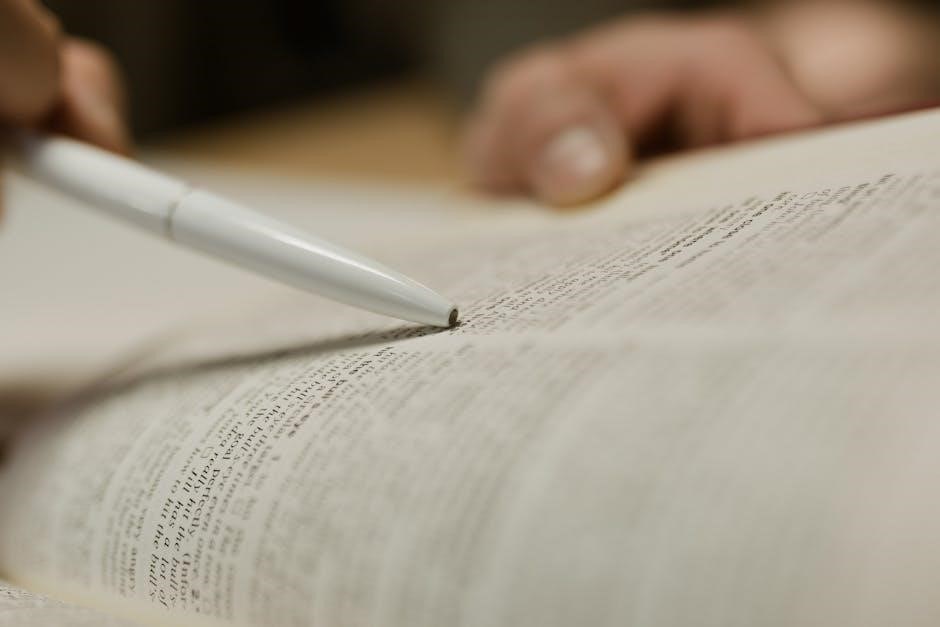Thyroid ultrasound-guided biopsy is a diagnostic procedure using ultrasound imaging to guide needle placement for tissue sampling. It ensures accuracy and minimizes complications, with CPT codes 76536 and 76942 covering the ultrasound and guidance aspects, respectively.
1.1 Overview of Thyroid Biopsy Procedures
Thyroid biopsy procedures involve obtaining tissue samples from thyroid nodules to assess for malignancy or other abnormalities. Fine needle aspiration (FNA) and core needle biopsy (CNB) are common methods. FNA uses a thin needle to collect cell samples, while CNB uses a larger needle to obtain tissue cores. Both procedures are typically performed under ultrasound guidance to ensure precise needle placement. Ultrasound imaging helps identify the nodule’s location and guides the needle accurately, reducing complications. These procedures are essential for diagnosing thyroid conditions, such as cancer, and determining appropriate treatment plans. The use of ultrasound enhances the accuracy and safety of thyroid biopsies, making them a critical diagnostic tool in thyroid care.
1.2 Importance of Ultrasound Guidance in Biopsy
Ultrasound guidance plays a pivotal role in thyroid biopsy procedures by enhancing precision and safety. It allows real-time visualization of the thyroid gland and nodules, ensuring accurate needle placement. This reduces the risk of complications, such as bleeding or damage to surrounding structures. Ultrasound guidance also minimizes the likelihood of incomplete or inaccurate sampling, improving diagnostic confidence. Additionally, it enables the targeting of non-palpable nodules that cannot be felt during a physical exam. The use of ultrasound guidance is particularly valuable for deep or difficult-to-access nodules, making the biopsy process more efficient and reliable. Overall, ultrasound guidance significantly improves the efficacy and safety of thyroid biopsy procedures, ensuring optimal patient outcomes.

CPT Codes for Thyroid Ultrasound-Guided Biopsy
Primary CPT codes for thyroid ultrasound-guided biopsy include 76536 for the ultrasound and 76942 for ultrasound guidance during needle placement, ensuring accurate billing for procedures.
2.1 Primary CPT Code for Thyroid Ultrasound (76536)
CPT code 76536 is the primary code for thyroid ultrasound procedures, specifically for diagnostic imaging of the thyroid gland. This code covers the ultrasound examination, including real-time imaging, necessary for evaluating thyroid nodules or abnormalities. It is essential for billing purposes when performing thyroid ultrasound-guided biopsies, as it represents the foundational imaging component of the procedure. The code applies to both initial and follow-up examinations, ensuring accurate visualization of thyroid structures. Proper use of 76536 ensures reimbursement for the ultrasound portion of the biopsy process, distinguishing it from additional codes required for the biopsy procedure itself or ultrasound guidance.
2.2 Additional CPT Codes for Biopsy Procedures
Beyond the primary ultrasound code, additional CPT codes are required for the biopsy procedure itself. For fine needle aspiration (FNA), codes 10005 and 10006 are used, with 10005 for the first nodule and 10006 for any additional nodules sampled. Core needle biopsy (CNB) procedures are coded using 60100. These codes are essential for accurately billing the biopsy procedure, distinguishing between FNA and CNB methods. It is important to note that these codes do not include ultrasound guidance, which is billed separately under code 76942. Proper use of these codes ensures comprehensive reimbursement for both the imaging and biopsy components of the procedure. Always consult current coding guidelines to avoid billing errors.
2.3 CPT Code for Ultrasound Guidance (76942)
CPT code 76942 is specifically designated for ultrasound guidance during needle placement in biopsy procedures. This code is used to bill the imaging component of the procedure, ensuring accurate needle placement and enhancing procedural safety. It is essential to report 76942 alongside the primary biopsy codes, such as 10005 or 60100, to capture the complete service provided. This code applies to both fine needle aspiration (FNA) and core needle biopsy (CNB) procedures. Proper documentation of ultrasound guidance is critical for accurate billing, as it reflects the use of real-time imaging to direct the biopsy needle. Always verify payer policies to confirm coverage and reimbursement for this code. Accurate coding ensures proper compensation for the ultrasound guidance aspect of the biopsy procedure.

Thyroid Biopsy Procedure Details
Thyroid biopsy involves removing tissue samples for diagnostic evaluation, often using fine needle aspiration (FNA) or core needle biopsy (CNB), guided by ultrasound for precision.
3.1 Fine Needle Aspiration (FNA) Biopsy
Fine Needle Aspiration (FNA) biopsy is a minimally invasive procedure to collect thyroid tissue samples for cytological evaluation. It uses a thin needle, often guided by ultrasound, to target nodules. CPT codes 10005 and 10006 are typically used for the first and additional nodules, respectively. Ultrasound guidance enhances precision, reducing complications. This method is preferred for its simplicity and low risk, providing diagnostic clarity for thyroid abnormalities.
3.2 Core Needle Biopsy (CNB)
Core Needle Biopsy (CNB) involves using a slightly larger needle than FNA to obtain a tissue core for histological examination. It is often performed under ultrasound guidance to ensure precise targeting of thyroid nodules. The CPT code 10022 is commonly used for this procedure, which may be billed separately when ultrasound guidance is employed (CPT 76942). CNB is typically recommended when FNA results are inconclusive or when a larger tissue sample is needed for diagnostic clarity. The procedure is well-tolerated, with minimal discomfort, and provides valuable information for assessing thyroid nodules. Ultrasound guidance enhances the accuracy of needle placement, reducing the risk of complications and improving diagnostic outcomes.
3.3 Role of Ultrasound in Guiding the Biopsy
Ultrasound plays a critical role in guiding thyroid biopsies by providing real-time imaging to precisely locate nodules and direct the needle. This enhances accuracy, minimizing the risk of complications and ensuring tissue samples are taken from the correct area. The use of ultrasound guidance is coded separately using CPT 76942, reflecting its essential role in the procedure. By visualizing the thyroid gland and surrounding structures, ultrasound helps avoid vital structures, making the biopsy safer and more effective. This imaging modality is particularly valuable for small or difficult-to-access nodules, ensuring diagnostic reliability and improving patient outcomes. The integration of ultrasound guidance in biopsy procedures is a cornerstone of modern thyroid diagnostics.

Billing and Coding Guidelines
Accurate coding is essential for proper billing of thyroid ultrasound-guided biopsy procedures. Use CPT code 76536 for the ultrasound and 76942 for guidance. Adhere to payer guidelines for reimbursement.
4.1 Coding for Multiple Thyroid Nodules
Coding for multiple thyroid nodules requires careful documentation. For each additional nodule sampled, use CPT code 10006, ensuring accurate billing for each biopsy site. Proper documentation of each nodule’s location and sampling is essential for correct coding and reimbursement. This ensures that each biopsy is accounted for separately, avoiding billing errors. Always verify payer guidelines for specific requirements regarding multiple nodule billing to ensure compliance and optimal reimbursement.
4.2 Billing for Separate Lesions
Billing for separate lesions in thyroid ultrasound-guided biopsy requires distinct coding for each lesion. Use CPT code 10005 for the first nodule and 10006 for additional nodules. If separate biopsies are performed under ultrasound guidance, ensure each procedure is documented clearly. For example, if two distinct lesions are biopsied, code 10005 for the first and 10006 for the second. Always verify documentation to confirm separate procedures. Payer guidelines may vary, so ensure compliance with specific requirements. Accurate coding prevents billing errors and ensures proper reimbursement for each lesion’s biopsy. Clear documentation of each lesion’s location and sampling is crucial for correct billing.
4.3 Use of Modifier Codes
Modifier codes are essential for accurately billing thyroid ultrasound-guided biopsy procedures. Use modifier 50 for bilateral procedures to indicate both sides were sampled. Modifier 76 is used if the same procedure is repeated, while 77 applies for repeat procedures by the same physician. Modifier 27 is appropriate when multiple procedures are performed on the same day. These modifiers ensure proper reimbursement and prevent billing errors. Always append the correct modifier to the primary CPT code (e.g., 10005 or 10006) to reflect the specifics of the procedure. Proper documentation of the medical records is crucial to support the use of these modifiers. This ensures compliance with payer guidelines and avoids payment disputes.

Insurance and Reimbursement
Insurance coverage for thyroid ultrasound-guided biopsy varies by payer, with CPT codes 76536 and 76942 typically reimbursed. Reimbursement depends on medical necessity, patient demographics, and proper documentation.
5.1 Medicare Coverage for Thyroid Biopsy
Medicare typically covers thyroid biopsy procedures when deemed medically necessary. CPT codes 76536 (ultrasound) and 76942 (guidance) are commonly reimbursed under Medicare Part B. Coverage includes both fine-needle aspiration and core needle biopsies. Patients with suspicious nodules or diagnostic uncertainties often qualify. Proper documentation, including imaging results and clinical rationale, is essential for reimbursement. Medicare may deny claims if procedures are deemed unnecessary or lacking proper justification. Providers must adhere to Medicare’s coding and billing guidelines to ensure timely payment. Beneficiaries should verify coverage specifics with their Medicare administrator to understand any out-of-pocket costs or restrictions.
5.2 Private Insurance Policies
Private insurance policies generally cover thyroid ultrasound-guided biopsies when deemed medically necessary. CPT codes 76536 (thyroid ultrasound) and 76942 (ultrasound guidance) are typically reimbursed. Coverage often includes fine-needle aspiration (10005 for first nodule, 10006 for additional) and core needle biopsies. Insurers may require pre-authorization or documentation of suspicious findings. Patients should verify their plan details, as coverage and out-of-pocket costs vary. Proper coding and documentation are essential to avoid claim denials. Some policies may exclude certain procedures or require specific clinical criteria. Providers should ensure compliance with insurer guidelines to facilitate smooth reimbursement. Always check with the insurance provider for specific coverage terms and conditions.

Patient Preparation and Aftercare
Patient preparation includes avoiding blood thinners and fasting. Wear comfortable clothing and remove nearby jewelry. Aftercare involves applying pressure, using a cold compress, and monitoring for complications. Use CPT codes 76536 and 76942 for billing.
6.1 Pre-Biopsy Instructions
Patients should avoid blood thinners and medications like aspirin for 7-10 days before the procedure. Fasting may be required, depending on the facility’s guidelines. Wear comfortable clothing and remove jewelry near the biopsy site. Inform your healthcare provider about any allergies or medications, including blood thinners. Arrive 30 minutes early to complete paperwork. Bring a list of current medications and any relevant medical records. Avoid eating or drinking for 6-8 hours prior if general anesthesia is planned. Do not apply lotions or perfumes to the neck area. Plan for a driver if sedation is used. Follow specific instructions provided by your healthcare provider to ensure a smooth procedure. Use CPT codes 76536 and 76942 for billing purposes related to the ultrasound-guided biopsy.
6.2 Post-Biopsy Care
After the procedure, apply gentle pressure to the biopsy site for 10-15 minutes to minimize bleeding. Avoid strenuous activities for 24 hours. Monitor for signs of bleeding, swelling, or infection. Use over-the-counter pain relievers like Tylenol for discomfort. Keep the area clean and dry and cover with a bandage if needed. Contact your doctor if you experience severe swelling, prolonged bleeding, or difficulty breathing. Follow up with your healthcare provider for test results and further instructions. Ensure proper wound care to prevent complications. Use CPT codes 76536 and 76942 for billing related to the ultrasound-guided biopsy procedure. Adhere to all post-care guidelines to promote healing and prevent potential issues.

Clinical Indications for Thyroid Biopsy
Thyroid biopsy is indicated for suspicious nodules, diagnostic challenges, and abnormal imaging findings. It helps identify cancerous tissues early, guiding timely treatment. Use CPT code 76536 for ultrasound-guided procedures.
7.1 Suspicious Thyroid Nodules
Suspicious thyroid nodules are characterized by abnormal ultrasound features, such as irregular margins, increased vascularity, or microcalcifications. These findings often warrant a biopsy to rule out malignancy. Ultrasound-guided fine needle aspiration (FNA) is the preferred method for sampling suspicious nodules due to its precision and minimally invasive nature. The procedure uses sound waves to visualize the nodule, ensuring accurate needle placement. CPT code 76536 is used for the ultrasound portion, while 76942 covers the guidance for needle placement. Early identification of cancerous nodules is critical for timely treatment, making this procedure a vital diagnostic tool. Suspicious nodules are typically identified during routine thyroid exams or when symptoms like swelling or difficulty swallowing arise.
7.2 Diagnostic Challenges
Diagnosing thyroid nodules can present challenges, particularly in distinguishing benign from malignant lesions. Small nodule size, calcifications, and cystic components may complicate accurate tissue sampling. Additionally, overlapping ultrasound features between benign and malignant nodules can lead to inconclusive results. Fine needle aspiration (FNA) biopsy is often used to resolve these uncertainties, but challenges such as inadequate specimen collection or indeterminate cytology can arise. Ultrasound guidance enhances biopsy accuracy by ensuring precise needle placement, reducing diagnostic errors. CPT codes 76536 and 76942 are used for the ultrasound and guidance components, respectively. Despite these tools, clinical correlation and follow-up are essential for managing diagnostic uncertainties and ensuring optimal patient outcomes in complex cases.

Advanced Imaging Modalities
Advanced modalities like Doppler ultrasound and elastography enhance thyroid nodule evaluation, improving diagnostic accuracy for malignancy detection and guiding biopsies effectively under CPT code 76536.
8.1 Doppler Ultrasound in Thyroid Evaluation
Doppler ultrasound assesses blood flow to thyroid nodules, aiding in distinguishing benign from malignant lesions. Increased vascularity often suggests suspicious nodules, necessitating biopsy. This technique, under CPT 76536, enhances diagnostic accuracy, guiding further interventions effectively while ensuring precise tissue sampling for histopathological examination.
8.2 Comparison with Other Imaging Techniques
Ultrasound excels in thyroid evaluation due to its real-time imaging and cost-effectiveness. Unlike CT or MRI, it avoids radiation, making it safer for repeated use. While CT provides detailed cross-sectional views and MRI offers superior soft-tissue differentiation, ultrasound is preferred for guiding biopsies due to its precision and ease of use. The use of CPT codes like 76536 for ultrasound and 76942 for guidance underscores its role in efficient and accurate tissue sampling. This non-invasive nature ensures patient comfort and diagnostic reliability, solidifying ultrasound’s position as a primary tool in thyroid assessment and biopsy procedures.

Coding for Special Cases
Special cases, such as pediatric patients or complicated procedures, require specific coding. CPT codes like 76942 and 10005 are used for ultrasound-guided biopsies, ensuring accurate billing for unique scenarios.
9.1 Coding for Pediatric Patients
Coding for pediatric patients undergoing thyroid ultrasound-guided biopsy follows similar guidelines as adults, using CPT codes like 76536 for ultrasound and 76942 for guidance. While the procedure remains the same, pediatric cases may require additional documentation to reflect age-related considerations. The primary CPT code for the biopsy itself, such as 10005 for fine needle aspiration, is also applicable. It is essential to ensure accurate billing by documenting the use of ultrasound guidance and any additional procedures performed. Coding professionals should consult specific pediatric billing guidelines to avoid discrepancies and ensure compliance with payer requirements. Proper documentation of the patient’s age and medical necessity is crucial for reimbursement. Always verify with the latest coding updates and payer policies for pediatric cases.
9.2 Coding for Complicated Procedures
Coding for complicated thyroid ultrasound-guided biopsy procedures requires careful documentation of additional complexities. For instance, if the procedure involves multiple nodules or challenging anatomy, additional CPT codes may apply. The primary codes, such as 76536 for ultrasound and 76942 for guidance, remain the same. However, when complications arise, such as difficult needle placement or the need for additional imaging, modifier codes like -22 (increased complexity) may be appended. Coding professionals must ensure accurate reporting of all services performed, including any extra imaging or biopsy samples. Proper documentation of the complexity and medical necessity is essential for correct reimbursement. Always verify payer guidelines for specific requirements in complicated cases to avoid billing discrepancies. Accurate coding ensures fair compensation for the additional effort and expertise required in complex scenarios.

Emerging Trends in Thyroid Biopsy
Advances in ultrasound technology and molecular testing are transforming thyroid biopsy practices, enhancing diagnostic accuracy and enabling personalized treatment approaches for patients with thyroid nodules.
10.1 Advances in Ultrasound Technology
Recent advancements in ultrasound technology have significantly enhanced the precision and effectiveness of thyroid biopsy procedures. High-resolution imaging now provides clearer visualization of thyroid nodules, aiding in more accurate needle placement. Doppler ultrasound improves the assessment of blood flow, helping to distinguish benign from malignant lesions. Additionally, elastography, a newer modality, measures tissue stiffness, further refining diagnostic capabilities. These innovations, combined with the use of CPT codes like 76536 for ultrasound and 76942 for guidance, ensure streamlined billing and optimal patient care. Moreover, portable ultrasound devices and AI-driven imaging systems are emerging, offering improved accessibility and diagnostic confidence. These technological strides are revolutionizing thyroid biopsy, making it safer and more efficient for both clinicians and patients.
10.2 Molecular Testing in Biopsy Samples
Molecular testing in thyroid biopsy samples has emerged as a critical tool for enhancing diagnostic accuracy. By analyzing genetic material from biopsy specimens, healthcare providers can identify specific mutations or markers associated with thyroid conditions, such as cancer. This advanced testing complements traditional cytology, enabling earlier detection and personalized treatment plans. For instance, mutations like BRAF V600E or RAS can indicate malignancy, guiding surgical decisions. CPT codes such as 10005 and 10006 are often used for billing these procedures, ensuring proper reimbursement for both the biopsy and molecular analysis. These advancements not only improve patient outcomes but also align with modern precision medicine approaches, making thyroid care more targeted and effective.



